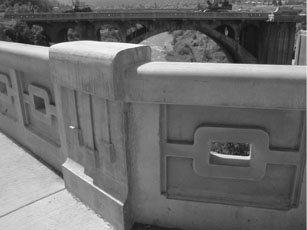U.S. Department of Transportation
Federal Highway Administration
1200 New Jersey Avenue, SE
Washington, DC 20590
202-366-4000
Focus
| Accelerating Infrastructure Innovations |
Publication Number: FHWA-HRT-04-021
Date: December 2003
Less construction noise and better workability. Improved quality and durability. Faster construction and higher strength. The use of self-consolidating concrete (SCC) in highway construction offers these benefits and more, with the potential for broad structural applications in the United States.
SCC, which does not require vibration to achieve full compaction, was first developed and used in Japan in the early 1990s for bridge building and tunnel construction. An SCC mix has a high degree of workability and remains stable both during and after placement. SCC uses common ingredients, plus superplasticizers and viscosity modifiers. The mix must meet three key property requirements:
Eliminating vibration cuts down on the labor needed and speeds up construction, resulting in cost savings and less traffic disruption. It also reduces the noise level in concrete plants and at construction sites and reduces aggregate segregation, honey combing, and voids in the concrete. The overall concrete quality is improved, as problems associated with vibration, such as under vibration, over vibration, or damage to the air void structure, are eliminated. Also improved is the concrete's resistance to chloride intrusion and ability to withstand freeze thaw damages.
|
|
| This photo shows Double-T beams constructed using SCC. |
Several European countries formed a consortium in 1996 to develop SCC for practical applications in Europe. Over the past 5 years, SCC bridges and structures have been constructed in such countries as the Netherlands, Sweden, and the United Kingdom. For example, SCC has been used on the Sodra Lanken project in Stockholm, which is the largest ongoing infrastructure project in Sweden. The project will provide a 6-km (3.7-mi) four-lane link from west to east in the southern part of the city. It includes seven major junctions, with bridges, earth retention walls, tunnel entrances, and concrete box tunnels. Begun in 1998, the project is slated to wrap up in 2004.
SCC has primarily been used for parts of the Sodra Lanken construction that are difficult to compact by the normal vibration method, including rock tunnel entrances, retention walls, and underground installation structures. For example, two of the project's parallel tunnels did not have a full rock cover. To stabilize the tunnels and achieve a strong and solid structure, concrete arches were constructed with SCC. The wall sections of the arches were 5-m (16-ft) high, 9- to 16-m (29- to 52-ft) long, and 0.8-m (2.6-ft) thick. The concrete was pumped through a 12.7-cm (5-in) steel pipe from a mobile concrete pump. To ensure an almost continuous flow of concrete into the formwork, two agitating trucks standing side by side to each other discharged the SCC mix. In comparison with other arches cast using conventional techniques, the SCC ones were judged to be of better quality, with good surface evenness and finish that did not require any repairs for rock pockets or other surface defects.
Lessons learned from SCC projects in Japan and Europe include the understanding that the production of SCC requires more experience and care than that of conventional vibrated concrete. Although most common concrete ingredients and mixers can be used for producing SCC, mixes must be properly designed and tested to assure compliance with the project specifications. All commonly used formwork materials are suitable for SCC; However, during cold weather placement of the concrete, it may be necessary to insulate the formwork to maintain the temperature and normal setting time. SCC is more sensitive to temperature during the hardening process than vibrated concrete. SCC also tends to dry faster than conventional vibrated concrete, as there is little or no water near the concrete surface. The concrete should be cured as soon as practical after placement to prevent surface shrinkage cracking.
The initial cost of SCC may be higher than that of conventional concrete because of the admixtures used. However, when used in Japan and Europe, material cost increases of about 4 percent were offset by labor cost decreases of 33 percent, for a total cost decrease of about 7 percent per project.
"SCC has high potential for greater acceptance and wider applications in highway bridge construction," says M. Myint Lwin, Director of the Office of Bridge Technology at the Federal Highway Administration (FHWA). A new National Cooperative Highway Research Program project will focus on developing design and construction specifications for SCC to supplement the American Association of State Highway and Transportation Officials' Load and Resistance Factor Design specifications. The South Carolina Department of Transportation, meanwhile, has received an Innovative Bridge Research and Construction (IBRC) grant from FHWA to study the use of SCC in drilled shafts. The Kansas Department of Transportation (KSDOT) has also received an IBRC grant to study the use of SCC in prestressed concrete bridge girders. KSDOT will build a three-span bridge, using SCC in all of the prestressed concrete girders for one of the spans, with the other spans being constructed using Kansas's standard concrete mixes. The bridge's performance will then be monitored for 5 years.
More information on SCC is available in the paper, "Applications of SCC in Japan, Europe, and the U.S.," by Masahiro Ouchi, Sada-aki Nakamura, Thomas Osterberg, Sven-Erik Hallberg, and M. Myint Lwin. To obtain a copy or for additional information on SCC and how it is being implemented, contact M. Myint Lwin at 202-366-4589 (email: myint.lwin@fhwa.dot.gov).
|  |
| These photos above show an SCC bridge railing constructed in Spokane, Washington. | |
|
|
| An SCC box segment |